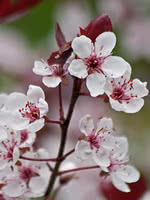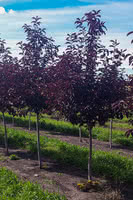Mon-Fri 9am - 5pm Mountain time
Purple Leaf Sand Cherry vs Robert Chokecherry
Prunus x cistena
Prunus virginiana Robert
CUSTOM GROW
NOT AVAILABLE THIS SEASON - MIGHT RETURN
Purple Leaf Sand Cherry provides bright reddish-purple leaves that turn bronze-green in the fall. In the spring, tiny flowers with a pinkish white hue bloom. The flowers are small, but the impact comes from the shrub blossoming all at once.
The Purple leaf sand cherry can be susceptible to pests and diseases in more humid areas; a typical life span is approximately 15 years. Not suitable for a privacy hedge on its own but is often alternated with lilacs. Often used as an accent plant that attracts birds and bees.
Developed in Barrhead, Alberta, the Robert Chokecherry produces very large berries (comparable to the size of grapes) with good yield.
The berries can be used for wine, jams, jellies and fresh picking, making it one of the sweeter chokecherries. Rich, red foliage make it a striking landscape addition.
Purple Leaf Sand Cherry Quick Facts
Robert Chokecherry Quick Facts
Toxicity: the leaves and seed are slightly toxic
Toxicity: Toxic to animals with segmented stomachs (horses, cattle, deer moose, etc.)

